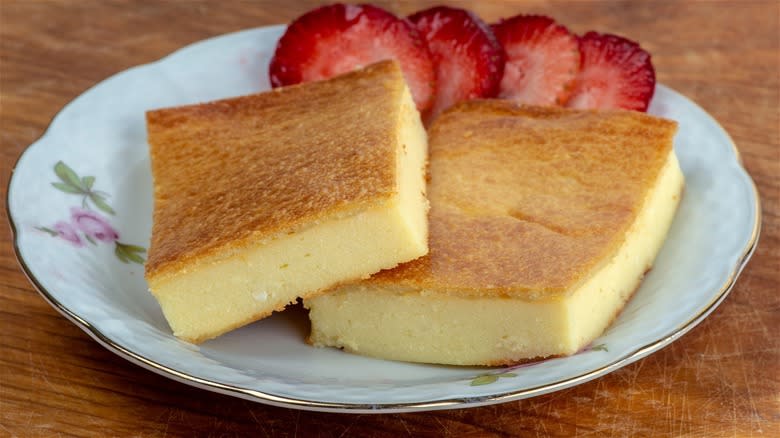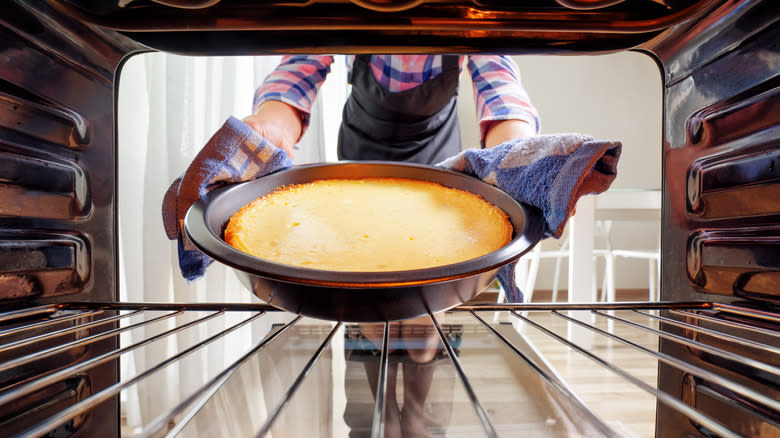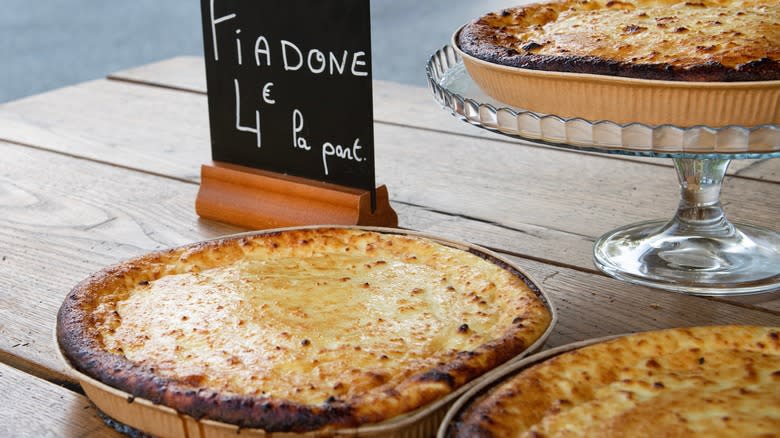Fiadone Is The Corsican Cheesecake You Deserve

There are many styles of cheesecake to love, but one you may not have heard of — and definitely need to try — is known as fiadone, a Corsican specialty. Corsica is a Mediterranean island and French territory that rests between Italy and France, and while it's certainly influenced by its neighbors, fiadone is uniquely Corsican. Its key ingredient is the national cheese, known as brocciu, which is a fresh sheep or goat's cheese.
Corsica is somewhat of an anomaly. Its mountainous hillsides welcome skiers in the winter, and tourists flock to its gorgeous beaches in the summer. It's upon these mountains that the island's goats and sheep graze. As their milk is the source of brocciu, fiadone is a symbol of the island's flavors, as well as its unique landscape and agriculture. After dinner in Corsica, fiadone is often served as a final course alongside a glass of dessert wine.
When exactly fiadone was created is unclear. However, based on the island's proximity to Italy and the dessert's similarity to Italian flans, its creation likely occurred sometime after the 16th century, when flans first made their way into cookbooks.
Read more: US Foods You Surprisingly Can't Find In Canada
The Basics Of Fiadone

Fiadone cheesecake is made with brocciu, a mild goat or sheep's whey cheese. Many European countries have their own varieties of goat and sheep cheese, such as France's chevre or Greece's galotyri, but just like fiadone, brocciu is distinctly Corsican and is a source of national pride. The 19th-century poet Émile Bergerat wrote of brocciu, "Whoever did not taste it does not know the Island." Brocciu lends fiadone a tantalizing, crumbly texture, unlike the stickier, custardy-style cheesecakes common in the U.S.
Filadone is also typically prepared with lemon zest, juice, eggs, butter, sugar, and oftentimes, a bit of brandy such as eau-de-vie, and/or vanilla extract. It doesn't contain any flour, which creates a very light cheesecake. You also won't find any graham cracker crusts beneath fiadone, as it's made without a crust. When the dessert is baked, it takes on a browned, caramelized top, which commonly cracks during the baking process. Traditionally, just like American cheesecakes, fiadone is served cold, so it will need time to chill after baking. However, some Corsicans say the dish can be eaten warm.
Fiadone Varies By Region

Because of Corsica's Mediterranean location, it shares some of its food culture with France and Italy, both of which have different takes on fiadone. For instance, while classic Corsican fiadone is made with brocciu, Italian versions instead use ricotta. This is likely because brocciu isn't as widely available and because ricotta is an Italian whey cheese. Ricotta has a slightly less tangy flavor than brocciu, which makes for a milder cheesecake, though it is a solid substitute.
Molise and Abruzzo, regions located in central Italy, have an Easter dessert also called fiadone, but it's very different from traditional fiadone. This dessert consists of ricotta-stuffed, ravioli-shaped pastries, sometimes also including raisins. Italy, Spain, and France also have comparable desserts that fall under the flan category, but fiadone remains unique in its cheesecake status. Notably, you can find Corsican-style fiadone in French patisseries.
Within the island, some fiadone recipes call for oranges rather than lemons. There's likely some variety in what's served alongside fiadone cheesecake, depending on the family recipe and what produce is available. Corsica is home to many fruit crops, including peaches, strawberries, cherries, and grapes, all of which would pair beautifully either fresh or as a coulis with the mild, creamy fiadone.
Read the original article on Mashed.

